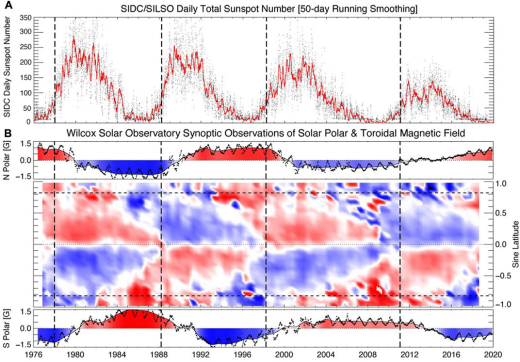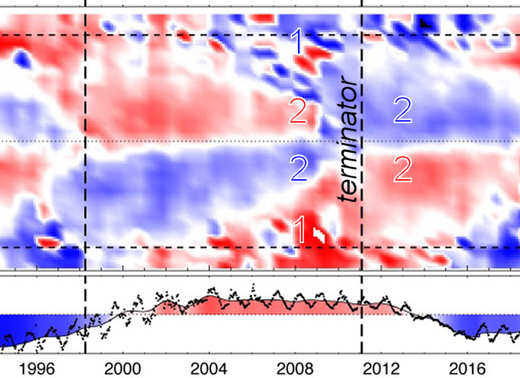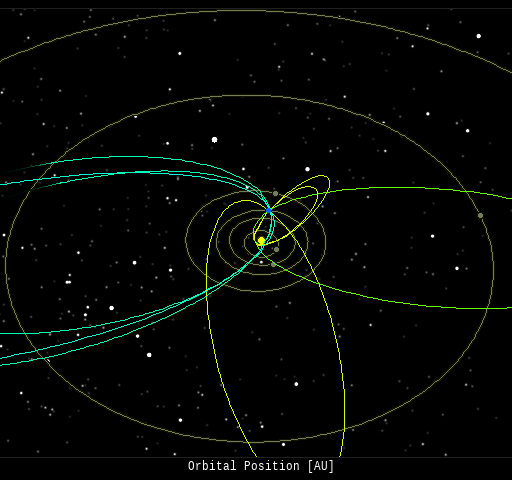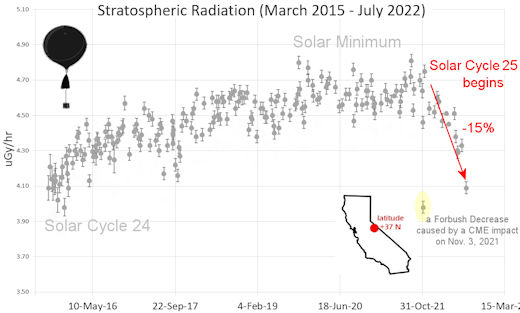Never miss another geomagnetic storm. Sign up for Space Weather Alerts and you'll receive a text message when magnetic storms erupt. Aurora tour guides and professional astronomers use this service. You can, too! | | |
NINE SUNSPOT GROUPS: Today, there are nine distinct sunspot groups crossing the face of the sun--the greatest number so far during young Solar Cycle 25. This would seem to boost the odds of a solar flare. However, all nine sunspots have stable magnetic fields disinclined to explode. Solar activity may remain low despite the high sunspot count. Solar flare alerts: SMS Text.
THE EXTENDED SOLAR CYCLE: So you thought you knew the solar cycle? Think again. A new paper published in Frontiers in Astronomy and Space Sciences confirms that there is more to solar activity than the well-known 11-year sunspot cycle. Data from Stanford University's Wilcox Solar Observatory (WSO) reveal two solar cycles happening at the same time, and neither is 11 years long.
"We call it 'the Extended Solar Cycle,'" says lead author Scott McIntosh of NCAR. "There are two overlapping patterns of activity on the sun, each lasting about 17 years."
Solar physicists have long suspected this might be true. References to "overlapping solar cycles" can be found in research literature as far back as 1903. A figure from the new Frontiers paper seems to clinch the case:

The top panel shows sunspot counts since 1976. The curve goes up and down every 11 years, which explains why everyone thinks the solar cycle is 11 years long. The bottom panel shows what's really going on.
"The red and blue colors represent magnetic fields on the surface of the sun," explains Phil Scherrer of Stanford University, a co-author of the paper who works closely with data from the Wilcox Solar Observatory. "We have been monitoring these fields since 1976, gathering a unique long-term record of the sun's magnetism."
Wilcox data show not one but two co-existing patterns of activity. They overlap in a way any music major will recognize: The sun is "singing rounds." A round is a musical piece in which multiple voices sing the same melody, but start the song at different times. Imagine a group of children singing "Row, row, row your boat." Half of the kids start first; the other half start 5 syllables later. The sun is doing the same thing with its magnetic fields, except instead of 5 syllables ("row, row, row your boat") the gap is a little more than 5 years.

In the zoomed-in image, above, two representative cycles are labeled "1" and "2". Most of the time both cycles are active, but not always. When one stops (....life is but a dream...), the other takes complete control of the sun and sunspot counts surge. This is when Solar Maximum happens. McIntosh calls the transition "the Terminator."
11 years vs. 17 years. 1 cycle vs. 2 cycles. What difference does it make?
"The Extended Solar Cycle may be telling us something crucial about what's happening deep inside the sun where sunspot magnetic fields are generated," says McIntosh. "It poses significant challenges to prevalent dynamo theories of the solar cycle."
Want to learn more? Milestone references in the development of the Extended Solar Cycle paradigm include Martin & Harvey (1979), Wilson et al (1988), Srivastava et al (2018).
Realtime Space Weather Photo Gallery
Free: Spaceweather.com Newsletter
GIFTS FROM THE EDGE OF SPACE: Christmas is coming. Are you looking for a far-out gift? Check out the Earth to Sky Store. It's filled with unique items that have flown to the edge of space onboard cosmic ray research balloons.

These unique gifts have floated above 99.7% of Earth's atmosphere, experiencing space-like blasts of cosmic rays, extreme cold, and a wild ride parachuting back to Earth after the balloon explodes. Even Amazon doesn't carry items this far out. Don't forget to enter coupon code "SPACESANTA" at checkout for a 10% holiday discount.
Far Out Gifts: Earth to Sky Store
All sales support hands-on STEM education
Realtime Aurora Photo Gallery
Free: Spaceweather.com Newsletter
Every night, a network of
NASA all-sky cameras scans the skies above the United States for meteoritic fireballs. Automated software maintained by NASA's Meteoroid Environment Office calculates their orbits, velocity, penetration depth in Earth's atmosphere and many other characteristics. Daily results are presented here on Spaceweather.com.
On Dec 12, 2022, the network reported 7 fireballs.
(3 sigma Hydrids, 2 Geminids, 1 sporadic, 1 Monocerotid)

In this diagram of the inner solar system, all of the fireball orbits intersect at a single point--Earth. The orbits are color-coded by velocity, from slow (red) to fast (blue). [Larger image] [movies]
Potentially Hazardous Asteroids (
PHAs) are space rocks larger than approximately 100m that can come closer to Earth than 0.05 AU. None of the known PHAs is on a collision course with our planet, although astronomers are finding
new ones all the time.
On December 12, 2022 there were 2320 potentially hazardous asteroids.
 |
Recent & Upcoming Earth-asteroid encounters: | Asteroid | Date(UT) | Miss Distance | Velocity (km/s) | Diameter (m) |
| 2022 WK9 | 2022-Dec-07 | 6.1 LD | 14.3 | 33 |
| 2022 XT | 2022-Dec-07 | 3.3 LD | 13.7 | 25 |
| 2022 XZ | 2022-Dec-08 | 10.1 LD | 18.7 | 26 |
| 2022 WO10 | 2022-Dec-08 | 5 LD | 4.8 | 10 |
| 2022 XU | 2022-Dec-09 | 19.2 LD | 14.7 | 45 |
| 2022 WP11 | 2022-Dec-09 | 11.9 LD | 17.3 | 63 |
| 2022 XJ | 2022-Dec-09 | 6.8 LD | 10.2 | 17 |
| 2022 WW | 2022-Dec-10 | 19.2 LD | 6.2 | 30 |
| 2019 XY | 2022-Dec-10 | 3.6 LD | 12.9 | 9 |
| 2022 XV | 2022-Dec-10 | 4.7 LD | 13.9 | 48 |
| 2003 YS70 | 2022-Dec-13 | 10.4 LD | 4.1 | 5 |
| 2019 XQ1 | 2022-Dec-13 | 14.5 LD | 9.8 | 30 |
| 2018 XU3 | 2022-Dec-13 | 14.8 LD | 10.3 | 28 |
| 2022 XY | 2022-Dec-14 | 11.4 LD | 4.4 | 27 |
| 2021 XS4 | 2022-Dec-14 | 14.5 LD | 9.7 | 23 |
| 2022 XX | 2022-Dec-14 | 0.5 LD | 6.6 | 7 |
| 2015 RN35 | 2022-Dec-15 | 1.8 LD | 5.9 | 85 |
| 2022 XO | 2022-Dec-15 | 8.4 LD | 8.6 | 21 |
| 2022 WU11 | 2022-Dec-17 | 11.6 LD | 10.5 | 31 |
| 2016 YE | 2022-Dec-18 | 18.6 LD | 4.8 | 23 |
| 2014 HK129 | 2022-Dec-20 | 6.7 LD | 11.6 | 216 |
| 2017 XQ60 | 2022-Dec-21 | 18.8 LD | 16 | 45 |
| 2022 UD9 | 2022-Dec-22 | 4.6 LD | 10.3 | 159 |
| 2022 RD2 | 2022-Dec-22 | 13.9 LD | 1.1 | 7 |
| 2022 XN | 2022-Dec-24 | 8.5 LD | 11 | 49 |
| 2013 YA14 | 2022-Dec-25 | 2.7 LD | 10.5 | 68 |
| 2022 TE14 | 2022-Dec-25 | 11.2 LD | 7 | 127 |
| 2018 YK2 | 2022-Dec-26 | 15.8 LD | 15.1 | 98 |
| 2022 WV9 | 2022-Dec-27 | 6.5 LD | 7.2 | 42 |
| 2010 XC15 | 2022-Dec-27 | 2 LD | 10.1 | 182 |
| 2021 AE | 2022-Dec-28 | 16.5 LD | 15 | 23 |
| 2021 NF | 2023-Jan-02 | 17.9 LD | 11.3 | 40 |
| 2011 WR41 | 2023-Jan-03 | 15.8 LD | 8.9 | 34 |
| 2019 AY3 | 2023-Jan-04 | 16.8 LD | 19.7 | 62 |
| 2021 TL | 2023-Jan-09 | 14.2 LD | 8.5 | 75 |
| 2014 LJ | 2023-Jan-14 | 4.8 LD | 3.5 | 7 |
| 2012 BV13 | 2023-Jan-16 | 12.2 LD | 6.7 | 134 |
| 2020 BP | 2023-Jan-20 | 5.2 LD | 16.9 | 26 |
| 2019 BO2 | 2023-Jan-24 | 12.1 LD | 16.2 | 21 |
| 2019 BZ4 | 2023-Jan-24 | 16.5 LD | 5.6 | 20 |
| 2020 BZ14 | 2023-Jan-26 | 8.8 LD | 6.7 | 54 |
| 2022 SO113 | 2023-Jan-29 | 10.5 LD | 3.5 | 73 |
| 2017 DU34 | 2023-Feb-02 | 13.3 LD | 11.2 | 16 |
| 367789 | 2023-Feb-03 | 4.7 LD | 9.9 | 149 |
| 2020 OO1 | 2023-Feb-04 | 4.8 LD | 7.7 | 19 |
| 2022 CX1 | 2023-Feb-09 | 17.4 LD | 13.2 | 14 |
Notes: LD means "Lunar Distance." 1 LD = 384,401 km, the distance between Earth and the Moon. 1 LD also equals 0.00256 AU. | | Cosmic Rays in the Atmosphere |
SPACE WEATHER BALLOON DATA: Almost once a week, Spaceweather.com and the students of Earth to Sky Calculus fly space weather balloons to the stratosphere over California. These balloons are equipped with sensors that detect secondary cosmic rays, a form of radiation from space that can penetrate all the way down to Earth's surface. Our monitoring program has been underway without interruption for 7 years, resulting in a unique dataset of in situ atmospheric measurements.
Latest results (July 2022): Atmospheric radiation is decreasing in 2022. Our latest measurements in July 2022 registered a 6-year low:

What's going on? Ironically, the radiation drop is caused by increasing solar activity. Solar Cycle 25 has roared to life faster than forecasters expected. The sun's strengthening and increasingly tangled magnetic field repels cosmic rays from deep space. In addition, solar coronal mass ejections (CMEs) sweep aside cosmic rays, causing sharp reductions called "Forbush Decreases." The two effects blend together to bring daily radiation levels down.
.Who cares? Cosmic rays are a surprisingly "down to Earth" form of space weather. They can alter the chemistry of the atmosphere, trigger lightning, and penetrate commercial airplanes. According to a study from the Harvard T.H. Chan school of public health, crews of aircraft have higher rates of cancer than the general population. The researchers listed cosmic rays, irregular sleep habits, and chemical contaminants as leading risk factors. A number of controversial studies (#1, #2, #3, #4) go even further, linking cosmic rays with cardiac arrhythmias and sudden cardiac death.
Technical notes: The radiation sensors onboard our helium balloons detect X-rays and gamma-rays in the energy range 10 keV to 20 MeV. These energies span the range of medical X-ray machines and airport security scanners.
Data points in the graph labeled "Stratospheric Radiation" correspond to the peak of the Regener-Pfotzer maximum, which lies about 67,000 feet above central California. When cosmic rays crash into Earth's atmosphere, they produce a spray of secondary particles that is most intense at the entrance to the stratosphere. Physicists Eric Regener and Georg Pfotzer discovered the maximum using balloons in the 1930s and it is what we are measuring today.
| | The official U.S. government space weather bureau |
| | The first place to look for information about sundogs, pillars, rainbows and related phenomena. |
| | Researchers call it a "Hubble for the sun." SDO is the most advanced solar observatory ever. |
| | 3D views of the sun from NASA's Solar and Terrestrial Relations Observatory |
| | Realtime and archival images of the Sun from SOHO. |
| | information about sunspots based on the latest NOAA/USAF Active Region Summary |
| | current counts of failed and deployed Starlink satellites from Jonathan's Space Page |
| | Authoritative predictions of space junk and satellite re-entries |
| | from the NOAA Space Environment Center |
| | fun to read, but should be taken with a grain of salt! Forecasts looking ahead more than a few days are often wrong. |
| | from the NOAA Space Environment Center |
| | the underlying science of space weather |
 | BestCSGOGambling is the best site for everything related to CSGO gambling on the web |
 | To find reviews of new online casino sites in the UK try The Casino DB where there are hundreds of online casino reviews complete with bonuses and ratings. Alternatively, Online-Casinos.xyz is another massive directory of online casinos listing sites for the UK and Worldwide. Casinos that offer Rupees for bonuses are very generous to Indian players. Find the best online casinos in India at AllCasinos.in Looking for a new online casino? Try Casimpo the new site dedicated to making online casino simple, or check out the new Avenger Slots Casino and Ace Online Casino with over 500 online slots and casino games. |
 | When looking for casinos to play online when the weather is bad, you can try casino online trucchi for Italian games. If you are not from Finland you can try the Swedish page Svenska casino online to find suitable games, check out svenskacasinoonline.net. Always check your local laws before playing with real money. |
 | Looking for sports betting companies not registered on GamStop? CasinoGap has presented a list of sites not on GamStop available for UK players. Check and bet online! Would you like to bet at sites not using GamStop? Look at a list of NonStopCasino sites for online betting that aren't on GamStop. Top-rated bookmakers ever! |
| | These links help Spaceweather.com stay online. Thank you to our supporters! |
| | | | | | |

